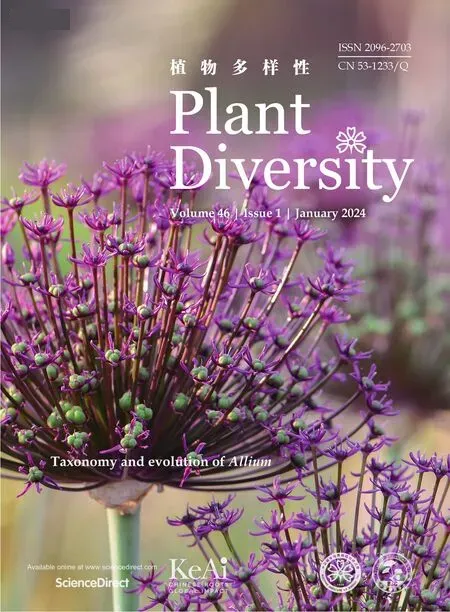Integrating high-volume molecular and morphological data into the evolutionary studies of Allium
The genusAllium(Amaryllidaceae),which includes economically important plants such as onions,garlic,and leeks,is one of the most species-rich and diverse genera of monocotyledon plants in the Northern Hemisphere (Govaerts et al.,2021),with approximately 1000 species.The evolution ofAlliumis characterized by ecological diversification,with most species preferring open,sunny and fairly dry habitats,although others are adapted to forests,European subalpine grasslands and moist subalpine environments,Himalayan alpine steppes,Central Asian alpine mountains,gravel fields along riverbanks,and even saline environments (Fritsch and Friesen,2002).Alliumspecies are widely distributed,however,nowhere is their radiation more magnificent than in the region that extends from the Mediterranean to Central and Southwest Asia,as well as within North America (Fritsch and Abbasi,2013),each of which harbors several hundred endemic species.
Studies on the evolutionary history ofAlliumspecies (e.g.,Friesen et al.,2006; Li et al.,2010; Hauenschild et al.,2017; Han et al.,2019;Xie et al.,2020)have identified three evolutionary lineages (Li et al.,2010) consisting of 15 subgenera: the subgeneraNectaroscordum,AmeralliumandMicroscordum;the subgeneraCaloscordum,Anguinum,Vvedenskya,PorphyroprasonandMelanocrommyum,most of which,excludingAnguinum,are endemic to eastern and central Asia,as well as the Mediterranean; and the subgeneraButomissa,Cyathophora,Rhizirideum,Allium,Cepa,PolyprasonandReticulatobulbosa,which comprise 60% ofAlliumspecies.Despite this progress,few studies have been able to generate a reliableAlliumphylogeny that is consistently resolved and strongly supported.This limitation has made it difficult to estimate divergence times,propose biogeographical histories and identify macroevolutionary patterns withinAllium.
Several factors may explain why research has failed to elucidate phylogenetic relationships withinAllium.Alliumis a species-rich,cosmopolitan genus,in which hybridization and polyploidization is common between species(Han et al.,2019;Li et al.,2021b).These factors have led to complex morphological and genetic parallels between species.Although the advent of phylogenomics has shed light on the phylogenetic relationships of numerous organisms,few studies have successfully used this approach withAllium,as the large genome size (>7.6 Gb,https://cvalues.science.kew.org)and high heterozygosity ofAlliumspecies (Sun et al.,2020; Liao et al.,2022) result in low mapping rates that require high computational power.In addition,severalAlliumlineages have undergone recent evolutionary radiations,leading to extensive morphological and genetic polymorphisms,consequently magnifying the challenges of reconstructing a well-resolved phylogeny for the genus (e.g.,Friesen et al.,2006,2021; Li et al.,2010,2016,2021a,2021b; Seregin et al.,2015; Herden et al.,2016; Sinitsyna et al.,2016; Xie et al.,2020).Thus,many questions remain concerningAlliumtaxonomy and evolutionary history.
In this issue,two papers onAlliummay exemplify how to solve some of these long-standing puzzles.Jang et al.,2023 examine flower characteristics to provide key taxonomic information forAlliumspecies delimitation.Flower morphology is one of the major traits used to assessAlliumtaxonomy,however,no studies have documented its taxonomic importance and systematic significance.This study provides a research paradigm for how to use morphological traits to assessAlliumspecies taxonomy along a phylogenetic tree.Using this framework,the major traits of subgenera and sections,as well as their species,can be circumscribed in future work when combined with more morphological traits.Moreover,using detailed morphological traits,interspecific hybrids may also be discriminated from the parent species and excluded in subsequent phylogenetic analyses.Consequently,when a strongly supported and wellresolved phylogeny ofAlliumis provided,character evolution can be further studied.Phylogeny-based trait evolution is often plagued by genome-wide gene-tree discordance (GTD).Previous studies have indicated that individual plastome fragments typically do not provide satisfactory resolution withinAllium(Friesen et al.,2006; Li et al.,2010).Although complete plastomes have been widely used to resolve phylogenetic relationships within someAlliumlineages (e.g.,Xie et al.,2020; Cheng et al.,2022; Yang et al.,2023),the value of this approach is limited when reconstructing plastome phylogenies of multiple species (Xie et al.,2020).These limitations are exacerbated at both deep and shallow nodes where incomplete lineage sorting(ILS) and cross-species introgression are likely to have occurred.One solution to these problems is the use of transcriptome data,which has been shown to produce reliable phylogenies (Cheon et al.,2020).In this issue,Zhang et al.,2023 use this phylotranscriptomic approach to produce a strongly-supported species tree for theAlliumsubg.Cyathophora.However,a high GTD was found across the genomes of subg.Cyathophora,as well as the discrepant topologies between the species tree based on these transcriptome data and chloroplast genome tree.Coalescence simulation illustrates that these discrepancies withinAlliumsubg.Cyathophoraare a product of ILS,indicating that hemiplasy accounts for interspecific trait transitions along the species tree.Ultimately,this robust phylogeny lays a solid foundation for ongoing work on the generic classification of the subgenera and sections ofAlliumthat will allow analyses of character evolution,biogeography and spatiotemporal evolution.
Author contribution
Xing-Jin He:Conceptualization,Data curation,Writing - original draft,Writing - review&editing.
Declaration of competing interest
No conflict of interest.
Acknowledgements
This research was supported by the National Natural Science Foundation of China (Grant Nos.32100180,32070221,32170209,31270241).
- 植物多樣性的其它文章
- Flower morphology of Allium (Amaryllidaceae) and its systematic significance
- Phylotranscriptomic discordance is best explained by incomplete lineage sorting within Allium subgenus Cyathophora and thus hemiplasy accounts for interspecific trait transition
- How to fill the biodiversity data gap:Is it better to invest in fieldwork or curation?
- Life forms affect beta-diversity patterns of larch forests in China
- A phylogenetic approach identifies patterns of beta diversity and floristic subregions of the Qinghai-Tibet Plateau
- Community structure and species diversity dynamics of a subtropical evergreen broad-leaved forest in China: 2005 to 2020

